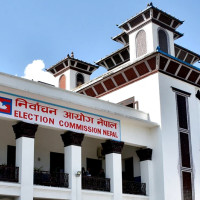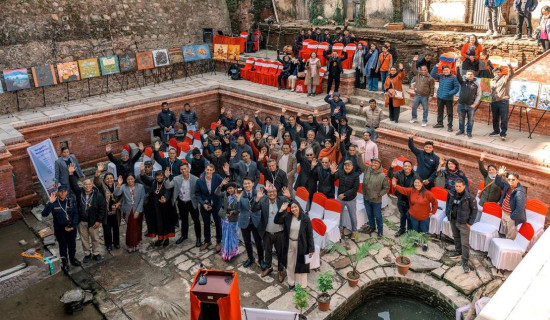- Monday, 8 December 2025
Nepali film industry emits bright ray of hope this year
Kathmandu, Apr. 13: The year 2081 BS, beginning on April 13, ushered in a wave of hope and enthusiasm for the Nepali film industry, marking a promising and vibrant chapter in its journey.
This year, a total of 61 Nepali films were released in movie theatres. Among them, a handful stood out for their commercial success. Films like Purna Bahadurko Sarangi, 12 Gaun, Chhakka Panja 5, Boksi Ko Ghar, Anjila, Pujar Sarki and a few others pulled audiences and performed remarkably well at the box office.
Among them, Purna Bahadurko Sarangi set a milestone by becoming the first Nepali movie to earn approximately Rs. 500 million in the domestic market and around Rs. 250 million abroad, bringing its total earnings to around Rs. 750 million worldwide, according to the film’s producer, Ramesh Chaulagain.
Chaulagain further added that the film was made on a budget of around Rs. 40 million, and they had expected it to earn just about Rs. 100 million.
Speaking about the film’s success, he said, “We didn’t cast popular actors, but seeing the craft of the artists, we were confident the film would do well.”
He added that the film’s gross collection exceeded all expectations. “A good combination of artists, a strong story, and filmmakers who understand cinema greatly contribute to a film’s success,” he added.
According to the box office report, 12 Gaun, starring Biraj Bhatt and his son Samir Bhatt, earned about Rs. 200 million, while the social comedy Chhakka Panja 5, by Deepak Raj Giri and Deepa Shree Niraula, collected over Rs. 150 million from ticket sales. Keki Adhikari’s horror film Boksi Ko Ghar earned Rs. 100.2 million, placing it among the top four highest-grossing films in the year.
Likewise, Anjila, a biopic based on the life of Anjila Tumbapo Subba, captain of Nepal’s women’s national football team, is still running in theatres and has so far earned around Rs. 80 million, as per box office collection report.
Films such as Pujar Sarki, Ghar Jwai, Pharki Pharki, Laaj Sharanam, Mansara, Gaun Aayeko Bato, and Khushma also did modest business, adding to the growing optimism surrounding the Nepali cinema.
Highlighting the industry’s overall performance, Dinesh DC, Chairperson of the Nepal Film Development Board (FDB), said that around four to five films typically become superhits each year, while eight to 10 others are considered successful, with the rest struggling to sustain a theatrical run.
“This trend continued this year, but films earned significantly more revenue compared to previous years. Movies of all genres were released, proving that Nepali audiences are now open to diverse storytelling,” said DC.
“If this trend continues, we can expect a surge in film production next year. I have been approving 10 to 11 film production proposals per week, which shows that filmmakers are highly encouraged by the current success rate and the growing audience interest,” DC added.
Meanwhile, films like Shambhala, Gaun Aayeko Bato and The Red Suitcase garnered critical acclaim, winning multiple awards at both national and international film festivals. These movies were celebrated not only for their storytelling but also for their artistic excellence.
This year, 83 foreign films were released in Nepali theatres. According to box office data, Pushpa 2: The Rule earned Rs. 264.48 million with 844,921 tickets sold. In second place, Kalki 2898 AD earned Rs. 125.74 million, followed by the horror-comedy Stree 2, which grossed Rs. 81.14 million. Singham Again earned Rs. 49.68 million. However, Hollywood films underperformed in Nepali theatres this year.
According to Narendra Maharjan, President of the Nepal Motion Picture Association, this year has been a prosperous one for the Nepali film industry, with domestic films outperforming both Bollywood and Hollywood films at the local box office.
“Theatre owners now prefer screening Nepali films due to higher profits and fewer complications. However, despite the growth in film production, the number of cinema halls has dropped from 450 to 160,” said Maharjan.
He further added that high taxes, expensive land, and lack of financing hinder new theatre construction. To sustain growth, the government must officially recognise cinema as a valuable industry like other industries and support the expansion of cinema halls.
Actor, producer, and director Deepak Raj Giri remarked that any film earning more than Rs. 100 million is considered a blockbuster. “The number of average hits has also increased. If 10 to 12 films become hits in a year, that should be seen as a great success. Currently, Nepali films are dominating the cinema halls. Except for a couple of Hindi films, most foreign films failed to succeed in the domestic market,” he added.
However, Giri expressed concern that the rise in the number of Nepali films has also brought about unhealthy competition. “Earlier, filmmakers had to wait for their turn to release a film. Now, they even have to wait for a turn to shoot,” said Giri.
According to box office data, the Nepali film market grossed over Rs. 2.6 billion this year, combining both domestic and foreign films. Of this, 59 Nepali films earned Rs. 1.8 billion, while 83 foreign films made Rs. 895.8 million.
The year ended with the release of the much-anticipated action films Karma and Pitambar on April 11. Their success and earnings will be revealed next year.
Artists highly appreciated
Two actors captured the spotlight this year, receiving immense love from audiences along with high praise from filmmakers and critics.
Samir Bhatt, a new face in the Nepali film industry, made his debut with 12 Gaun. Despite his first appearance on the silver screen, he delivered a powerful performance that left a lasting impression. His natural acting talent and screen presence have led many to believe he could become the next superstar of Nepali cinema.
On the other hand, seasoned actor Bijay Baral, who has dedicated nearly two decades to theatre and supporting roles, finally rose like a blazing sun in the Nepali celluloid sphere. His performance in Purna Bahadurko Sarangi not only made history but also opened new doors of opportunity and recognition in his career.
This year also saw the release of films starring popular actors such as Anmol KC, Pradeep Khadka, Paul Shah, Dayahang Rai, Pooja Sharma, Swastima Khadka, among others. However, more than star power, story-driven films and strong performances that resonated better with audiences.
Around the Nepali New Year, Degree Maila M.A. 3rd Class and The Red Suitcase were released on April 12 last year. While Degree Maila did moderately well at the box office, The Red Suitcase, despite its screenings at international festivals, couldn’t make a significant commercial impact.
Female participation this year
The first film released this year was Boksi Ko Ghar, which premiered on April 26 and sparked a surge at the box office. The film was produced by Keki Adhikari, while the year concluded with Pitambar and Karma. Pitambar, an action film, is directed by Krisha Chaulagain. This involvement signals that female participation indirection and production has been steadily increasing in the film industry.
This year, actresses and filmmakers such as Reecha Sharma, Keki Adhikari, Deepa Shree Niraula, Krisha Chaulagain, Pooja Sharma, Shilpa Maskey, and Richa Ghimire played significant roles in film production and direction, further strengthening women’s presence in the industry.
According to Krisha Chaulagain, the increasing involvement of women in directing and producing films is a notable and positive trend. “I have heard many women are entering the industry, and this is a good shift. The Nepali film sector has created a Rs. 500 million market, and it will be a great challenge to surpass this mark next year,” she added.
Women have been especially active this year, making films across various genres such as horror, comedy, social, and action.
However, she expressed concern that ongoing political turmoil could hamper the industry’s growth.
“From a cinematic perspective, this year has been quite pleasant. But political disturbances may affect how the Nepali cinema industry advances in the future,” she added.

















